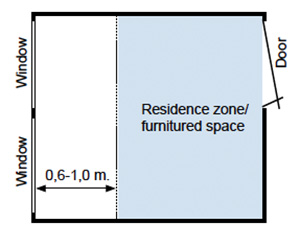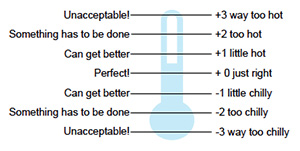Indoor climate and error reporting
Here you will find out how the indoor climate works, how to proceed when it does not work as it should and also some tips for how you can influence your indoor environment.
The indoor climate is an integral part of the work environment and a significant part of our environmental work. Akademiska Hus and KTH have high environmental targets to reduce energy use and CO2 emissions.
Akademiska Hus ensures that all systems function as they should and that ventilation and temperature are set correctly. EECS Service ensures that they fulfil their part as a landlord. But you can also influence the perceived indoor climate.
Government assignment: energy saving in government agencies
The government has instructed all public authorities in Sweden "to implement energy-saving measures in public administration". Work is underway to implement measures at KTH. The amount of electricity purchased and energy-saving measures shall be regularly reported to the government up to and including April 2023.
KTH's energy saving and how you can contribute
We prefer different

The difficulty of finding the right temperature indoors is thus connected to the fact that we are individuals with different preferences. The experience of an indoor climate is very individual, but some factors influence the perceived temperature:
- What you wear.
- If you spend your day sitting down or moving around.
- Where you work in the room.
- Your home temperature and your daily routine.
Your clothes play a significant role in how you experience the temperature in the workplace. In the summer, you often want a higher temperature as you dress thinner during that time — the perceived temperature difference between sitting still, standing up and keeping moving amounts to around 3°C. A jacket or cardigan gives about a 2°C difference, while an undershirt, long-sleeved shirt or sweater gives a 0.5°C difference.
How much you exert yourself physically matters. For example, it takes significantly more energy to stand up and work than to sit down. Therefore, we would like it to be a little cooler during standing, moving work compared to sedentary office work.
It is more challenging to regulate the temperature if you work near windows or doors that affect the indoor climate.
What temperature you want in the workplace is also affected by how hot it is in your home. It can also depend on your daily routine. If you are alert and rested, it probably doesn't matter what the temperature is. On the other hand, the risk of feeling frozen increases if you have a bad day or if it's rainy and grey.
The indoor climate applies to the building's occupancy zone

The concept of residence zone is used in the indoor environment area. This means that the requirements placed on the room's temperature must be met within the residential zone.
The Housing Authority's definition of the residential zone is:
- One decimeter above the floor.
- One meter in front of the window.
It can therefore be assumed that the requirements for the indoor climate are not always sufficient outside the residence zone.
The thermal comfort is calculated for a group

The thermal comfort scale assesses how people perceive the temperature indoors, from -3 to +3, with seven steps. The median value, 0, represents the neutral experience when one is completely satisfied. The scale is about calculating what a group of individuals think on average. Although the average would be in the middle of the scale, some will find it too cold, and some will find it too hot. It won't be easy to find technical systems that can create climates that satisfy each individual's wishes.
The indoor climate guide
This page is a summary of the Indoor Guide for KTH Campus. The guide has been produced in collaboration between Akademiska Hus and KTH.
